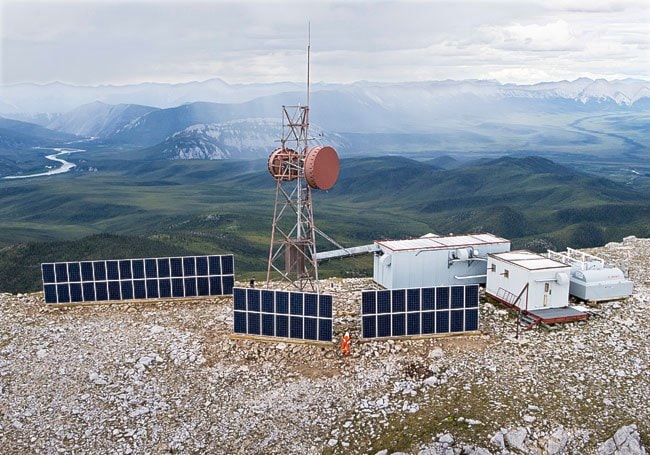A pilot project testing if solar panels can be used to power one of NorthwesTel’s microwave sites is up and running.
The photovoltaic array set up at the Engineer Creek site, 200 kilometres north of Dawson City, is now in operation.
Construction of the project began in July, and after some testing, the equipment has so far functioned as expected, the company says.
For the next year, staff with NorthwesTel and the Cold Climate Innovation department of the Yukon Research Centre at Yukon College will monitor the effectiveness of the solar cells in replacing the diesel normally used to power the equipment’s battery.
Cold Climate Innovation director Stephen Mooney said solar panels, once they’re installed, have one of the lowest operations and maintenance costs of all alternative energy sources - something that’s particularly important when dealing with remote locations.
“When it comes to remote locations, you don’t want to have to helicopter in every two weeks to manage things,” he said.
NorthwesTel spokesperson Emily Hoefs said there were many factors that motivated the company’s decision to give this method a try.
“We’re very happy with the win-win-win situation this project provides. Besides the environmental benefits - the reduction in CO2 emissions as we decrease our diesel fuel consumption - the project can also result in less engine maintenance, fewer trips to the site for fuel transport, and reduced operating costs overall, to name but a few,” she said.
Mooney estimates the average cost of airlifting diesel fuel to remote sites at between $2.50 and $3 a litre, but he said that number could be as high as $5.
Hoefs would not say how much diesel Engineer Creek site used before the solar panels were installed, citing the confidentiality of NorthwesTel’s operating costs.
The prediction is that the system will produce 11,000 kilowatt hours of power annually.
If everything runs smoothly, the company is hoping it could reduce its diesel consumption by up to two-thirds, she said.
The 15-kilowatt array has been in the planning stages for about a year.
The solar panels will power the site for most of the year with the exception of a small amount of diesel during the winter months.
NorthwesTel currently has 156 microwave stations. Of these, 87 rely on independent sources of power and 37 are only accessible by helicopter.
“If the technical operation of the PV array and the business case prove sustainable, NorthwesTel has many other sites that would benefit from the addition of solar energy,” Hoefs said.
From Cold Climate Innovation’s perspective, the data collected from the project will be useful on many fronts, Mooney said.
The solar panels are pointed in slightly different directions - south and southwest - to test which direction is able to catch the most rays.
“One of the big questions is if these panels are going to be able to withstand the weather,” Mooney said. “There are 80, 100, or sometimes 120 km/h winds. Are these panels going to stay where they are or are they going to end up blown down in the valley?”
A video camera has been set up to monitor conditions and help determine whether the panels are affected by snow buildup over time.
Cold Climate Innovation contributed $35,000 to the project for access to the data. NorthwesTel contributed about $100,000.
Contact Ashley Joannou at
ashleyj@yukon-news.com
